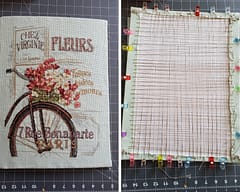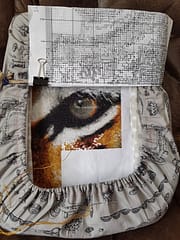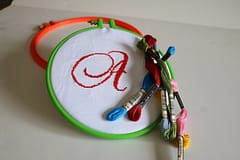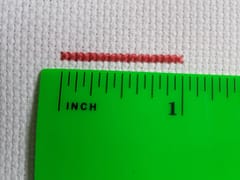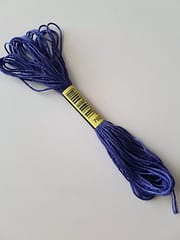Money Saving Tips for Stitching
Making the most of your money
Contents
Introduction
Stitching on a Budget
Times are tough. Inflation is up and the cost of living is at an all time high and looks like it’s going to keep rising. Many of us have to cut back on spending to make ends meet and unfortunately, luxuries such as spending on hobbies is often one of the first things to be sacrificed. Putting gas in your vehicle, food on your table and a roof over your families head has to take priority.
But in tough times, more than ever, some enjoyment is essential for mental health and well-being. So what can we do to keep stitching if the budget is tight? Here are some ideas to save money so that you can keep pursuing your hobby.
Don’t hoard what you don’t need
When you love a thing, your chosen hobby, you often want to surround yourself with it. Not just the essentials, but the tools and accessories as well.
As pattern sellers this first one may seem a little counter-productive, but stop buying patterns!
We stitchers are an optimistic bunch. Hands up - how many of us have 100+ years worth of patterns tucked away somewhere? I know I do !
Unless it’s some limited edition pattern that will be going back into the vaults forever, it makes no sense to buy a pattern just to have it. Sure, it feels great having the stash of patterns but the only point of a pattern is to stitch a piece from it.
Not only does it represent money committed and now sat in a draw but there’s a risk of loss. If it’s paper, it may be damaged or lost. If it’s electronic it could also be corrupted or lost.
What people don’t realize is that patterns can expire. Think about it, any pattern purchased created after DMC introduced the new 01-35 range is potentially superior to those produced before, because they can posisbly take advantage of new thread colors that match better to those in the original image. Who knows if or when new thread colors will be introduced in future, but when they are every pattern already created risks being inferior to those produced with those available. This also works the other way in that colors can be discontinued or become difficult to source.
Not only that, but technology always improves. We’re very proud of the pattern converter we first released in 2017 as it was a step-up in quality compared to others available. But since then we’ve found ways to make improvements to it and have a list of further enhancements we can make that can improve quality.
Think back 10 or 20 years … was the quality of patterns produced back then as good as patterns that can be made now? No, and in another 10 to 20 years they will be better again. As technology improves and new agorithms and improvements to approaches for color matching, dithering and other things can be applied.
So buying a pattern that you’re not going to be stitching soon can be a waste.
Our tastes also change. What we love as an image now may be something we’re less enthralled with 5 or 10 years from now. I have definately made that mistak, I look back at some charts that I have bought and now realized I will never stitch them.
Sales are only bargains if it’s something you need and will use.
Organization
Keep your thread organized by colour code, this way you know exactly what you have at all times so you will avoid buying duplicate threads unnecessarily. Same with fabrics, keep a record of what you have on hand so when a new project calls you know exactly what you already have.
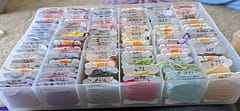
Kitting Up
Kitting up projects is a great thing … if you sell kits! But if you have multiple WIPs in progress, do you really need skeins of thread pre-purchased for each one? Think about it, all you’re doing is paying for everything up front. The money could be in your bank account instead of the sellers. It’s not like they are going to stop making thread and you won’t be able to buy it - so treat the store as your stock-room, in the same way that you do for groceries. No one buys years worth of groceries upfront, you buy them as you use and need them.
By having your own pool of thread that you can pull from when you need you reduce the stock you have on-hand. This is what stores themselves do when times are tight - reduce inventory that’s sat on the shelf or, even worse, stuck in a store-room. Anything that’s in a draw or a box and not being used is a cost - something you’ve paid for but so far haven’t used.
Of course there are times you may want to buy threads up front - if you’re going to be stitching a solid block of one color, you may want to ensure that the dye lots are the same. But if you’re stitching a full-coverage piece of a photo or painting where those stitches are spread throughout the project the negligable difference between dye-lots will be imperceptible so over-buying isn’t necessary.
Consider trying out some of the less expensive threads such as CXC. Now this isn’t as available and there is typically a longer lead-time but it can be significantly cheaper so allow you to keep more of a stash if you want at a lower price, but still, that stash can be pooled between projects.
Note too: buying the complete range of thread may feel great because you have a complete set, but unless your patterns require those colors you may be buying something just to keep it in a drawer or box.
Framing Yourself
You spend a long time working on a project so naturately you then want to display it but framing is expensive so why not trying framing your piece yourself. At first this can seem intimidating but it is actually quite easy and will save a lot of money.
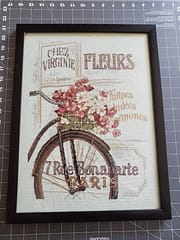
Sometimes, spending less money can be a false economy. Buying cheaper hoops or needles may save money but sometimes spending a little more for something of higher quality that will last longer is a better investment. My go to choice is a snap frame rather than a hoop, they are more expensive up front but are long lasting and inter-changable between sizes.
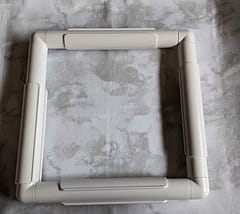
Be sure to like and follow us on our Thread-Bare Stitching Facebook Page and check out our links page for a full list of all of our social media channels and services Thread-Bare Links

